
A grain elevator is a facility designed to stockpile or store grain. In the grain trade, the term "grain elevator" also describes a tower containing a bucket elevator or a pneumatic conveyor, which scoops up grain from a lower level and deposits it in a silo or other storage facility.

Buffalo Central Terminal is a historic former railroad station in Buffalo, New York. An active station from 1929 to 1979, the 17-story Art Deco style station was designed by architects Fellheimer & Wagner for the New York Central Railroad. The Central Terminal is located in the city of Buffalo's Broadway/Fillmore district. Closed since 1979, several attempts to redevelop the site were unsuccessful. In February 2024 a new development team was formed to plan a reuse for the terminal.

Buffalo City Hall is the seat for municipal government in the City of Buffalo, New York. Located at 65 Niagara Square, the 32-story Art Deco building was completed in 1931 by Dietel, Wade & Jones.
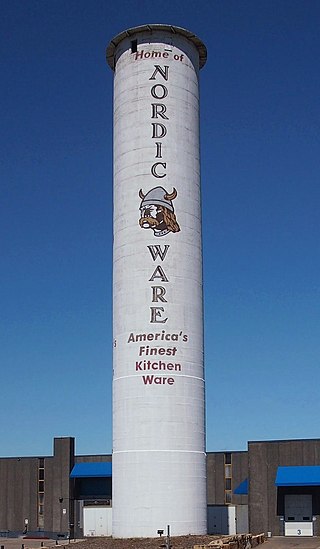
The Peavey–Haglin Experimental Concrete Grain Elevator is the world's first known cylindrical concrete grain elevator. It was built from 1899 to 1900 in St. Louis Park, Minnesota, United States, as an experiment to prove the design was viable. It was an improvement on wooden elevators that were continually at risk of catching fire or even exploding. Its cylindrical concrete design became the industry standard in the United States, revolutionizing grain storage practices. After its initial experiments, the Peavey–Haglin Elevator was never again used to store grain. Since the late 1960s it has been maintained on the grounds of the Nordic Ware company and is painted with their name and logo.

Edward M. Cotter is a fireboat in use by the Buffalo Fire Department at Buffalo, New York, United States. Originally named William S. Grattan, it was built in 1900 by the Crescent Shipyard of Elizabeth Port, New Jersey. Due to age, it was rebuilt in 1953 and renamed Firefighter upon its return to service. The following year it was renamed Edward M. Cotter. its namesake, Edward Cotter, was a Buffalo firefighter and leader of the local firefighters union who had recently died.

Northwestern Consolidated Milling Company Elevator A also known as the Ceresota Elevator and "The Million Bushel Elevator" was a receiving and public grain elevator built by the Northwestern Consolidated Milling Company in 1908 in Minneapolis, Minnesota in the United States. The elevator may have been the largest brick elevator ever constructed and ran on electricity. The elevator was the source for the Crown Roller Mill and Standard Mill. Those mills closed in the 1950s but the elevator continued in use for grain storage until the mid 1980s. The building is a contributing property of the St. Anthony Falls Historic District listed in the National Register of Historic Places in 1971. For this article north is toward the river.

The following are all the contributing resources to the Saint Anthony Falls Historic District in Minneapolis, Minnesota, United States. The District is listed on the National Register of Historic Places, thus these properties are on the NRHP. The "period of significance" of the District was 1858–1941. The district's archaeological record is considered to be one of the most-endangered historic sites in Minnesota.

Wollenberg Grain and Seed Elevator was a historic grain and seed elevator located at Buffalo in Erie County, New York. It was built in 1912 and remained in service until 1987. It was notable as the sole surviving example of a wooden or so-called "country style" elevator. It was built in the style of the earliest elevators dating to the 1840s and had a capacity of 25,000 bushels.

The Architecture of Buffalo, New York, particularly the buildings constructed between the American Civil War and the Great Depression, is said to have created a new, distinctly American form of architecture and to have influenced design throughout the world.

Mill City Museum is located in the ruins of the Washburn "A" Mill next to Mill Ruins Park on the banks of the Mississippi River in Minneapolis. The museum, an entity of the Minnesota Historical Society that opened in 2003, focuses on the founding and growth of Minneapolis, especially flour milling and the other industries that used hydropower from Saint Anthony Falls. The mill complex that the museum is within, dates from the 1870s and is listed on the National Register of Historic Places. It is also part of the St. Anthony Falls Historic District and within the Mississippi National River and Recreation Area.

The A. Mendelson and Son Company Building is located on Broadway in Albany, New York, United States. It is a brick industrial building erected in the early 20th century. In 2003 it was listed on the National Register of Historic Places. It is one of the few intact examples of the early 20th century industrial architecture of Albany.
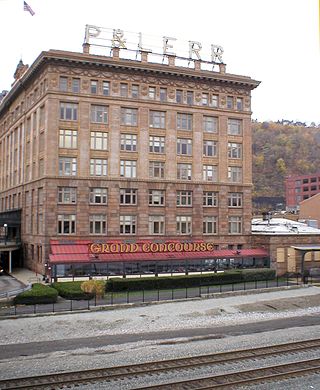
The Pittsburgh & Lake Erie Railroad Station, now Landry's Grand Concourse restaurant in Station Square Plaza in Pittsburgh, Pennsylvania, is an historic building that was erected in 1898. It was listed on the National Register of Historic Places in 1974.
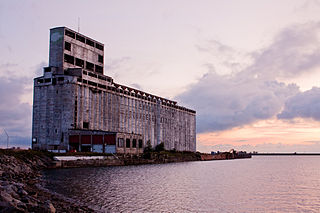
The Cargill Pool Elevator is a grain storage facility in Buffalo harbor built in the 1920s and previously named the Saskatchewan Cooperative Elevator. The elevator is the only grain elevator in Buffalo that is located directly adjacent to Lake Erie.

The Great Northern Elevator was a grain storage facility at 250 Ganson Street in Buffalo, New York. The elevator was located on the City Ship Canal and at the time of its completion in 1897, the elevator was the world's largest. The elevator was the first to employ cylindrical steel bins for grain storage, and also one of the first to run on electricity. The brick curtain wall did not support the bins or the working house and was designed as weatherproofing only.

American Grain Complex, also known as "The American", Russell-Miller Milling Co. Elevator, and Peavey Co. Elevator, is a historic grain elevator and flour milling complex located in South Buffalo, Buffalo, Erie County, New York. The complex consists of three contributing buildings and two contributing structures. They are the Elevator Building, Flour Building (1906-1924), office building, Moveable Marine Tower, and railroad tracks. The Elevator Building consists of the mainhouse, workhouse, and fixed marine tower, all built in 1905–1906, and an annex constructed in 1931. The complex was last owned by ConAgra Foods, who closed the elevator and mill in June 2001.
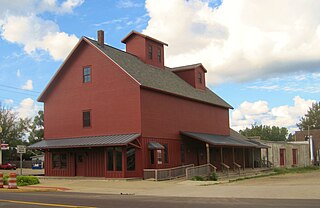
The Bangor Elevator is a grain elevator located at 142 West Monroe Street in Bangor, Michigan. It was listed on the National Register of Historic Places in 2009.
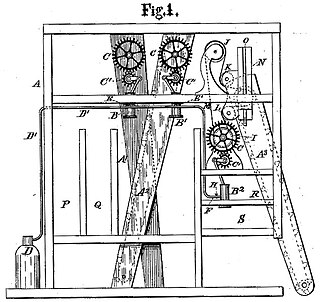
Robert Dunbar was a Scottish mechanical engineer. He designed the first steam-powered grain elevator in the world and the majority of the first grain elevators in Buffalo, New York City, and Canada.

The Erie Basin Marina is a municipal inland harbor in Buffalo, New York. The marina is primarily for residential usage, containing a large array of boat docks, gardens, and a public observatory overlooking the city and waterfront. The marina's harbor discharges into the Niagara River and Lake Erie.

The Historic Ely Elevator, also known as the Woitishek-King-Krob Elevator and Feed Mill, is an "iron-clad" wood-cribbed grain elevator, located in Ely, Iowa. The Historic Ely Elevator was built in 1900 along the Burlington, Cedar Rapids and Northern Railway. It is a contributing property of the Dows Street Historic District, which is listed on the National Register of Historic Places.

























